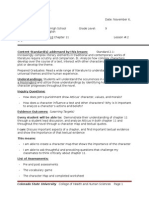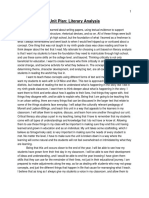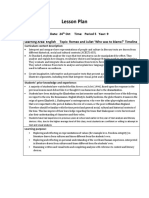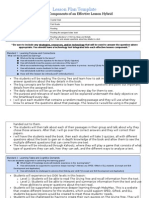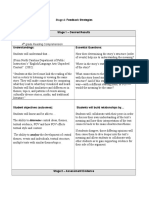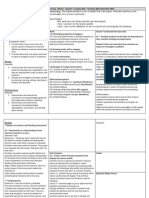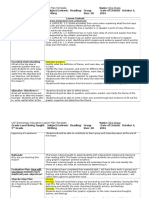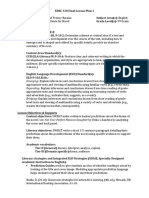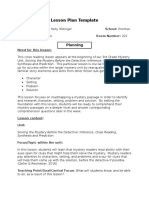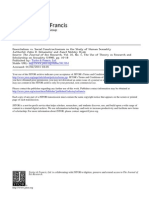Encyclopedia Brown Lesson Plan Final
Encyclopedia Brown Lesson Plan Final
Uploaded by
api-114762665Copyright:
Available Formats
Encyclopedia Brown Lesson Plan Final
Encyclopedia Brown Lesson Plan Final
Uploaded by
api-114762665Original Title
Copyright
Available Formats
Share this document
Did you find this document useful?
Is this content inappropriate?
Copyright:
Available Formats
Encyclopedia Brown Lesson Plan Final
Encyclopedia Brown Lesson Plan Final
Uploaded by
api-114762665Copyright:
Available Formats
Carley Marion and April Collins are teaching 4th grade at Meredith Elementary.
The students in our class have been learning the plot development of a story, and how to write a complete and accurate summary of a story. We will be working with small groups to refine and improve their skills in this area. The students will learn to analyze the plot development of a fictional story and be able to provide details and a summary of the story. Our learning goals are for the students to have a complete comprehension of plot development and how to write an accurate summary of a fictional story. We will teach them to be able to identify the exposition, rising action, climax and resolution of a story and give specific examples of each element from the passage. We will also review with the students how to write a complete and sequential summary of the story using plot development as guideposts in their writing. We will teach the students by reviewing the plot development and their definitions in an interactive way. We believe in employing different types of learning styles. Our lesson will employ both visual and kinesthetic learning (by providing definitions on card stock and the giving students the opportunity to color them in) as well as auditory learning (by verbally defining the plot development). Our underlying method of teaching is to engage the students by having them actively participate. We will have them provide their prior knowledge on plot development. We will have them give examples during the reading. Finally, we will have them work independently on writing exit slips. We will have the students create a graphic organizer during the lesson which will, once completed, provide them with concrete examples of the plot development and which they will use as a tool to organize their thoughts as they are reading along with the teacher (who will be reading the story aloud).
The students recently completed a unit on summarization and plot development. Some of the students struggled with the concepts and require further review (based on assessments done in class). We have planned this lesson in order to reinforce what was taught in class and give more personal attention to the students who struggled with the original lesson. Being able to identify and analyze plot development, as well as provide a summary is a standard in Pennsylvania for the fourth grade. Students are required to write accurate constructed responses for the PSSA in fourth grade, and this lesson gave us an opportunity to review those skills as well as skills in the Pennsylvania Curriculum Standards. We discussed different stories with our classroom mentor, who suggested the Encyclopedia Brown series. We decided it was accessible for the students who struggled with the original lesson, and because it was on reading level P and this is an appropriate level for almost all of the students who need extra assistance with this topic.
Goals / Objectives: Students will be able to summarize a passage of fiction and be able to analyze elements of the story including plot development (exposition, rising action, climax, falling action and resolution) characters and setting. Standards and Assessment Anchors: Assessment Anchor: Understand fiction appropriate to grade level. Standards: o R4.A.1.4.1: Identify and/or explain stated or implied main ideas and relevant supporting details from text. Note: Items may target specific paragraphs. Items might ask about information in the text that is most important or helpful for understanding a particular fact or idea. Items may require recalling key information stated in text. o R4.A.1.5.1: Summarize the key details and events of a fictional text as a whole. Materials and preparation List the materials you will need to prepare for the lesson. Child scissors Colored pencils Encyclopedia Brown Carries On by Donald J. Sobol (one copy per student) Worksheets with plot development and definitions for students to manipulate Graphic organizer for summary Pencils Exit slip Ziploc bags Classroom arrangement and management issues Students will be seated at rectangular tables in the library at a time when the library is unoccupied Students will bring their materials to the library (pencils and colored pencils); all other materials will be provided by the teacher in the library Expecting students may be boisterous; teachers will set expectations about behavior in the library. o Teachers have arranged to give the lessons during times when the library is available and there wont be additional distractions from other students
Lesson Plan (45 minutes) 1) The hook (8-10 minutes): The teacher will explain the lesson objective for students to be able to summarize a fictional story and identify appropriate plot development. The teacher will connect Encyclopedia Brown to a story previously read in class, A Clue in the Sand which is also falls under the genre of mystery. Access prior knowledge: o Ask students to define each of the five stages of plot development: Exposition character, setting Rising Action Climax Falling Action Resolution Teachers will then provide students with card stock printouts of the plot development and definitions that are not in a particular order. Students will cut out each definition and number them in the correct order from exposition to resolution. Students will be invited to illustrate each term and/or create symbols or a diagram of what these elements look like in a story, so that they will be more inclined to keep them and use them in the future. Ziploc bags will be provided to store them for future use. 2) The Body of the Lesson (22-25 minutes): Introduce Encyclopedia Brown Carries On by Donald J. Sobol and the passage the teacher will be reading aloud The Case of the Giant Mousetrap while students follow along in their copy of the book. (8 pages) The teacher will pause at the end of each stage of plot development in the story and ask students to analyze that section and provide an example or evidence supporting their reasoning why the passage corresponds with that stage o During each break of the passage, the students will utilize the graphic organizer to take notes for their summaries of the passage 3) Closure (10-12 minutes): Students will be given an exit slip to complete as an assessment tool o Exit slip: Where would the following quote fit into your summary of the story? In the beginning, middle or end? Explain your answer. Only his parents and his teachers called him by his real name, Leroy. Everyone else called him Encyclopedia. Questions will be interspersed sequentially as the teacher reads the story. The teacher will ask for volunteers to answer the questions. If the students answer incorrectly, the teacher will ask another student to answer and if two answers to the same question are incorrect, the teacher will guide students to the right answer and provide substantial evidence from the passage to support it.
Questions for discussion: 1.Who is Encyclopedia Brown? Who is his father? 2. Can you describe the exposition for me? 3. Give me two examples of rising action. 4. When was the climax? How do you know that? 5.Describe the resolution of the story. Assessment of the goals/objectives listed above: Exit slips will be used to assess student comprehension of the lesson and gather information about the extent of their understanding Exit slips will also be used to gauge if the lesson was effective Students will be graded using a scale of 0, 1, 2, 3: o 0: The response provides insufficient material and is inaccurate o 1: The response is incomplete and inappropriate details or examples have a major effect on accuracy o 2: The response provides a partial answer, which may contain minor inaccuracies o 3: The response provides a complete answer with specific, appropriate, and accurate details Anticipating students responses and your possible responses High expectations of student behavior and involvement will be set prior to the beginning of the lesson If students show marked difficulty with plot development, the teacher will provide concrete examples and evidence from the passage The teacher will also provide one-on-one assistance, while other students are independently completing exit slips Accommodations The teacher will also provide one-on-one assistance, while other students are independently completing exit slips Accommodations for students who may need greater challenge and/or finish early? Students can draw a picture on the back of their graphic organizer to support their summary of the story.
You might also like
- Asc (Saso) SeriesDocument65 pagesAsc (Saso) SeriesChoudhry Waqas Uddin.No ratings yet
- Fable Lesson Plan 3rd GradeDocument5 pagesFable Lesson Plan 3rd Gradeapi-253780200No ratings yet
- Online Job Portal Using PHP, MySQL Project Full ReportDocument31 pagesOnline Job Portal Using PHP, MySQL Project Full ReportSushant More82% (17)
- Lorax Lesson PlanDocument2 pagesLorax Lesson Planapi-252790280No ratings yet
- Science4 - q1 - Mod4b - Changes in Solid Materials When Hammered or Cut - v3Document26 pagesScience4 - q1 - Mod4b - Changes in Solid Materials When Hammered or Cut - v3Sally Consumo Kong85% (27)
- Literacy Lesson Plan and CommentaryDocument13 pagesLiteracy Lesson Plan and Commentaryapi-741926843No ratings yet
- Lesson Plan Template EDIS 5400: English EducationDocument24 pagesLesson Plan Template EDIS 5400: English Educationapi-340887844No ratings yet
- Whole Group Reading 2:17-2:10Document3 pagesWhole Group Reading 2:17-2:10api-282151856No ratings yet
- Childrens Lit Unit and Lesson PlansDocument18 pagesChildrens Lit Unit and Lesson Plansapi-384819868No ratings yet
- Amy Snyder Lesson PlanDocument12 pagesAmy Snyder Lesson PlanKris HopkinsNo ratings yet
- Unit Plan For Weebly 1Document21 pagesUnit Plan For Weebly 1api-278497008No ratings yet
- Harry Potter and The Sorcerer's Stone Creative Writing Unit 10th Grade English Prepared By: Casey Flaim For Dr. Michael Sherry Fall 2014, BUDocument39 pagesHarry Potter and The Sorcerer's Stone Creative Writing Unit 10th Grade English Prepared By: Casey Flaim For Dr. Michael Sherry Fall 2014, BUapi-252940348No ratings yet
- Literacy Lesson Plan 2Document4 pagesLiteracy Lesson Plan 2api-253457129No ratings yet
- Edu 542 Lesson 1Document6 pagesEdu 542 Lesson 1api-347962298No ratings yet
- Individual PlanDocument5 pagesIndividual Planapi-340109100No ratings yet
- Literacy Lesson ExemplarDocument6 pagesLiteracy Lesson Exemplarapi-734234347No ratings yet
- Eddn 680 - Siop 2nd Observation Lesson 1Document18 pagesEddn 680 - Siop 2nd Observation Lesson 1api-710356152No ratings yet
- Literacy Lesson Plan Part 1: Lesson Overview Virtual Lesson Based On Alicia Carrico's Classroom Columbus Elementary/Edwardsville School District #7Document22 pagesLiteracy Lesson Plan Part 1: Lesson Overview Virtual Lesson Based On Alicia Carrico's Classroom Columbus Elementary/Edwardsville School District #7api-528039579No ratings yet
- Texas Wesleyan University Lesson Plan: Domain-DimensionsDocument4 pagesTexas Wesleyan University Lesson Plan: Domain-Dimensionsapi-340630807No ratings yet
- Edtpa-Aligned Lesson For All ClassesDocument12 pagesEdtpa-Aligned Lesson For All Classesapi-267736442No ratings yet
- Formal Observation 1 10 14 14Document4 pagesFormal Observation 1 10 14 14api-242351866No ratings yet
- Dark Ages Lesson PlanDocument9 pagesDark Ages Lesson Planapi-310437278No ratings yet
- Engl 434 Grade 3 Autobiography LessonDocument2 pagesEngl 434 Grade 3 Autobiography Lessonapi-509287640No ratings yet
- Lesson 2 450Document7 pagesLesson 2 450api-257595875No ratings yet
- Lesson Sample 2Document5 pagesLesson Sample 2api-548684593No ratings yet
- Ccss - Ela-Literacy - Ccra.L.6: Lesson Plan TemplateDocument4 pagesCcss - Ela-Literacy - Ccra.L.6: Lesson Plan Templateapi-584365435No ratings yet
- Unit Plan Assignment 2Document13 pagesUnit Plan Assignment 2api-313149031No ratings yet
- (V & G) 7 Lesson PlansDocument23 pages(V & G) 7 Lesson PlansImran MaqsoodNo ratings yet
- Survivalunitfinal SlenkerDocument15 pagesSurvivalunitfinal Slenkerapi-337410968No ratings yet
- Teacher: Kristen Miro Lesson Number: 2 Lesson Title: Finding Theme in A Text ("The Message") Grade/Subject: Grade 4/ English Language ArtsDocument13 pagesTeacher: Kristen Miro Lesson Number: 2 Lesson Title: Finding Theme in A Text ("The Message") Grade/Subject: Grade 4/ English Language Artsapi-302923815No ratings yet
- Reading Lesson Plan: Title: Fact and Opinion Subject/Grade Level/ Date(s) : Time Requirements: Materials ListDocument6 pagesReading Lesson Plan: Title: Fact and Opinion Subject/Grade Level/ Date(s) : Time Requirements: Materials Listapi-455835172No ratings yet
- Lesson Plan: Curriculum ConnectionsDocument8 pagesLesson Plan: Curriculum Connectionsapi-295933754No ratings yet
- 9 Lesson 6Document6 pages9 Lesson 6api-372464959No ratings yet
- Lesson Plan TemplateDocument5 pagesLesson Plan Templateapi-298026665No ratings yet
- Daily Lesson Plan: VDOE English 10 ObjectivesDocument2 pagesDaily Lesson Plan: VDOE English 10 Objectivesapi-380276315No ratings yet
- Stage 4:: 4 Grade Reading ComprehensionDocument7 pagesStage 4:: 4 Grade Reading Comprehensionapi-301273473No ratings yet
- Harrell Lae4863 FlippedlessonseriesDocument21 pagesHarrell Lae4863 Flippedlessonseriesapi-325351137No ratings yet
- CT Unit PlanDocument11 pagesCT Unit Planapi-302777648No ratings yet
- Pact Teaching Event LessonsDocument11 pagesPact Teaching Event Lessonsapi-287818991No ratings yet
- Tws 5Document12 pagesTws 5api-246132572No ratings yet
- FlippedlessonsportfolioDocument28 pagesFlippedlessonsportfolioapi-325080363No ratings yet
- Guided NarrativeDocument4 pagesGuided Narrativeapi-296514525No ratings yet
- 9 Lesson 5Document6 pages9 Lesson 5api-372464959No ratings yet
- Lines of InquiryDocument3 pagesLines of InquiryteacherensNo ratings yet
- Mystery Bag 5 WH Writing Lesson PlanDocument4 pagesMystery Bag 5 WH Writing Lesson Planapi-236986052No ratings yet
- Pa1 Lesson PlanDocument6 pagesPa1 Lesson Planapi-293605947No ratings yet
- Gillikin Modified Lesson Plan One Summer 2020Document3 pagesGillikin Modified Lesson Plan One Summer 2020api-604380062No ratings yet
- Technology Integration Unit Plan - Full Plan For Entire UnitDocument27 pagesTechnology Integration Unit Plan - Full Plan For Entire UnithnhmomNo ratings yet
- Modified Lesson Plan A 5Document6 pagesModified Lesson Plan A 5api-242533177No ratings yet
- Reflective Lesson Plan-ElaDocument13 pagesReflective Lesson Plan-Elaapi-217594944No ratings yet
- Edla204 - Where The Wild Things Are Standard 3Document8 pagesEdla204 - Where The Wild Things Are Standard 3api-357949761No ratings yet
- Eddn 634 - Siop Lesson 1 Reading 1Document7 pagesEddn 634 - Siop Lesson 1 Reading 1api-710351904No ratings yet
- Usf Lesson Plan Template Oct 4Document4 pagesUsf Lesson Plan Template Oct 4api-337071056No ratings yet
- 01 Prediction GuideDocument5 pages01 Prediction Guideapi-449554197No ratings yet
- Language Arts Lesson Plan CharacterizationDocument2 pagesLanguage Arts Lesson Plan Characterizationapi-242651169No ratings yet
- PlannDocument6 pagesPlannCHRISTINE KARENDINo ratings yet
- Modern Fantasy Lesson PlanDocument3 pagesModern Fantasy Lesson Planapi-279876248100% (1)
- Learning To Use A Double Entry JournalDocument14 pagesLearning To Use A Double Entry Journalapi-357529176No ratings yet
- Unit Plan: Identifying and Discussing Story ElementsDocument50 pagesUnit Plan: Identifying and Discussing Story ElementsGaby MontesNo ratings yet
- Reading Comprehension Lesson Plan FinalDocument9 pagesReading Comprehension Lesson Plan Finalapi-254917183No ratings yet
- Lessonplan 2Document3 pagesLessonplan 2api-485134991No ratings yet
- 10 18 16 Observation Lesson Plan Kelly WillingerDocument13 pages10 18 16 Observation Lesson Plan Kelly Willingerapi-341625641No ratings yet
- Bosnian Genocide Graphic OrganizerDocument1 pageBosnian Genocide Graphic Organizerapi-114762665No ratings yet
- God Grew Tired of Us Lesson PlanDocument7 pagesGod Grew Tired of Us Lesson Planapi-114762665No ratings yet
- Rwandan Genocide Graphic OrganizerDocument1 pageRwandan Genocide Graphic Organizerapi-114762665No ratings yet
- Ghosts of Rwanda Lesson PlanDocument5 pagesGhosts of Rwanda Lesson Planapi-114762665No ratings yet
- Social Studies PowerpointDocument8 pagesSocial Studies Powerpointapi-114762665No ratings yet
- Longitude and LatitudeDocument22 pagesLongitude and Latitudeapi-114762665No ratings yet
- Azelis Indonesia DistribusiDocument7 pagesAzelis Indonesia Distribusifauzi.muhammad143No ratings yet
- Aviat 2' MW Dish-VHLP2-80 - A Product SpecificationsDocument5 pagesAviat 2' MW Dish-VHLP2-80 - A Product SpecificationsJonatan SilveraNo ratings yet
- CATALOGUE Biosynex 2021-ExportDocument56 pagesCATALOGUE Biosynex 2021-ExportHaitham Salama GhareebNo ratings yet
- N-Quotation of Hfqa-1800w 1 3Document13 pagesN-Quotation of Hfqa-1800w 1 3api-724687963No ratings yet
- 19 Circle pmd-2021Document15 pages19 Circle pmd-2021tikam chandNo ratings yet
- Electronic Reciprocating Saw Variable Speed 1 Inch Stroke: Owner'S ManualDocument12 pagesElectronic Reciprocating Saw Variable Speed 1 Inch Stroke: Owner'S Manualctrpoint2004No ratings yet
- Discussion of "Strain of Concrete at Peak Compressive Stress For A Wide Range of Compressive Strengths" by B.de Nicolo, L.Pani and E.PozzoDocument5 pagesDiscussion of "Strain of Concrete at Peak Compressive Stress For A Wide Range of Compressive Strengths" by B.de Nicolo, L.Pani and E.PozzoHatef SardariNo ratings yet
- BlitzStars Player Statistics & History For World of Tanks Blitz 2Document1 pageBlitzStars Player Statistics & History For World of Tanks Blitz 2Bob BuilderNo ratings yet
- Essentialism Vs Social ConstructionismDocument10 pagesEssentialism Vs Social ConstructionismRegia AndiNo ratings yet
- Mcintyre 2011Document15 pagesMcintyre 2011Mauricio RibeiroNo ratings yet
- What Are The Standard Puzzles Asked in Programming Interviews - QuoraDocument6 pagesWhat Are The Standard Puzzles Asked in Programming Interviews - QuoraRahul BhayaNo ratings yet
- WHLP Grade 3 Q2 MTBDocument2 pagesWHLP Grade 3 Q2 MTBAlemapSueNo ratings yet
- Hexion Vodnye Otverditeli I Smoly EngDocument6 pagesHexion Vodnye Otverditeli I Smoly EngCloudy DayNo ratings yet
- Supply Chain Management at World Co., LTDDocument9 pagesSupply Chain Management at World Co., LTDJam Sohail Ahmed Dahar100% (1)
- HardTimes2015 ReportDocument52 pagesHardTimes2015 ReportrupertaveryNo ratings yet
- LCD InterfacingDocument22 pagesLCD InterfacingNanduNo ratings yet
- Scrabble Is Better Than Chess PseudoDocument3 pagesScrabble Is Better Than Chess PseudoNikko San QuimioNo ratings yet
- Guidance For Midterm #1Document2 pagesGuidance For Midterm #1dinojerkNo ratings yet
- 10 1152@ajpcell 00016 2016Document14 pages10 1152@ajpcell 00016 2016Muttley ZNo ratings yet
- Report of Bajaj AllianzDocument47 pagesReport of Bajaj AllianzAnusha_SahukaraNo ratings yet
- Endurance Test Sit UpDocument2 pagesEndurance Test Sit UpDinyoga Bima WaskitoNo ratings yet
- PHYSICS INVESTIGATORY PROJECT Step DownDocument21 pagesPHYSICS INVESTIGATORY PROJECT Step DownMANSI CHAUDHARYNo ratings yet
- Open Versus Laparoscopic Surgery For Advanced Low.21Document7 pagesOpen Versus Laparoscopic Surgery For Advanced Low.21Sebas Mayorga NúñezNo ratings yet
- TIA-222F Structural Standards For Steel Antenna Towers and Antenna Supporting StructuresDocument120 pagesTIA-222F Structural Standards For Steel Antenna Towers and Antenna Supporting Structuresjucag66No ratings yet
- Collogative Properties: Vapor Pressure LoweringDocument3 pagesCollogative Properties: Vapor Pressure LoweringJunell TadinaNo ratings yet
- ORAN - O2 IMS AlignmentDocument7 pagesORAN - O2 IMS AlignmentRandhir kumar SinhaNo ratings yet























